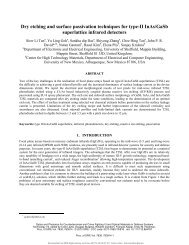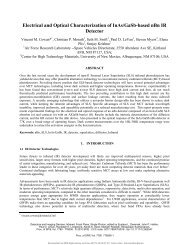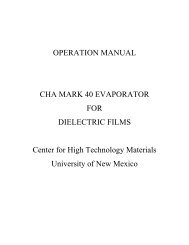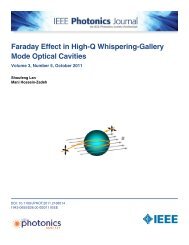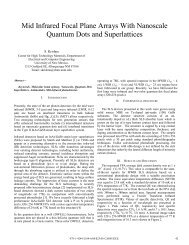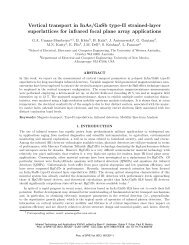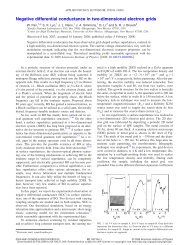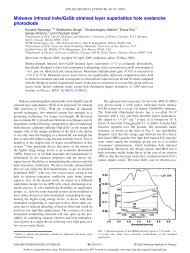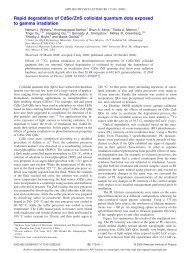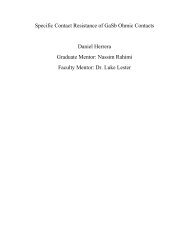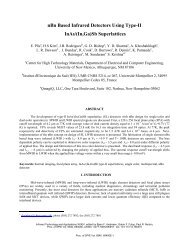Identification of quantum confined interband transitions in type-II ...
Identification of quantum confined interband transitions in type-II ...
Identification of quantum confined interband transitions in type-II ...
Create successful ePaper yourself
Turn your PDF publications into a flip-book with our unique Google optimized e-Paper software.
<strong>Identification</strong> <strong>of</strong> <strong>quantum</strong> <strong>conf<strong>in</strong>ed</strong> <strong><strong>in</strong>terband</strong> <strong>transitions</strong> <strong>in</strong> <strong>type</strong>-<strong>II</strong><br />
InAs/GaSb superlattices us<strong>in</strong>g polarization sensitive photocurrent<br />
spectroscopy<br />
Nutan Gautam, Ajit Barve, and Sanjay Krishna<br />
Citation: Appl. Phys. Lett. 101, 221119 (2012); doi: 10.1063/1.4767358<br />
View onl<strong>in</strong>e: http://dx.doi.org/10.1063/1.4767358<br />
View Table <strong>of</strong> Contents: http://apl.aip.org/resource/1/APPLAB/v101/i22<br />
Published by the American Institute <strong>of</strong> Physics.<br />
Related Articles<br />
Tailor<strong>in</strong>g the electronic properties <strong>of</strong> SrRuO3 films <strong>in</strong> SrRuO3/LaAlO3 superlattices<br />
Appl. Phys. Lett. 101, 223105 (2012)<br />
Half-metallic ferromagnetism <strong>in</strong> (CrN)1/(GaN)1 (001) and (VN)1/(InN)1 (001) superlattices<br />
J. Appl. Phys. 112, 083703 (2012)<br />
Hydrostatic pressure and stra<strong>in</strong> effects <strong>in</strong> short period InN/GaN superlattices<br />
Appl. Phys. Lett. 101, 092104 (2012)<br />
Effect <strong>of</strong> electrode resistance on dielectric and transport properties <strong>of</strong> multiferroic superlattice: A Impedance<br />
spectroscopy study<br />
AIP Advances 2, 032136 (2012)<br />
Valence band tail states <strong>in</strong> disordered superlattices embedded <strong>in</strong> wide parabolic AlGaAs well<br />
J. Appl. Phys. 111, 123523 (2012)<br />
Additional <strong>in</strong>formation on Appl. Phys. Lett.<br />
Journal Homepage: http://apl.aip.org/<br />
Journal Information: http://apl.aip.org/about/about_the_journal<br />
Top downloads: http://apl.aip.org/features/most_downloaded<br />
Information for Authors: http://apl.aip.org/authors<br />
Downloaded 05 Dec 2012 to 64.106.37.191. Redistribution subject to AIP license or copyright; see http://apl.aip.org/about/rights_and_permissions
APPLIED PHYSICS LETTERS 101, 221119 (2012)<br />
<strong>Identification</strong> <strong>of</strong> <strong>quantum</strong> <strong>conf<strong>in</strong>ed</strong> <strong><strong>in</strong>terband</strong> <strong>transitions</strong> <strong>in</strong> <strong>type</strong>-<strong>II</strong> InAs/GaSb<br />
superlattices us<strong>in</strong>g polarization sensitive photocurrent spectroscopy<br />
Nutan Gautam, Ajit Barve, and Sanjay Krishna a)<br />
Center for High Technology Materials, Electrical and Computer Eng<strong>in</strong>eer<strong>in</strong>g Department,<br />
University <strong>of</strong> New Mexico, Albuquerque, New Mexico 87106, USA<br />
(Received 2 October 2012; accepted 29 October 2012; published onl<strong>in</strong>e 29 November 2012)<br />
We report on the use <strong>of</strong> polarization sensitive photocurrent spectroscopy for identify<strong>in</strong>g the<br />
participat<strong>in</strong>g <strong>transitions</strong> <strong>in</strong> <strong>type</strong>-<strong>II</strong> InAs/GaSb stra<strong>in</strong>ed layer superlattice system. Transverse electric<br />
and transverse magnetic photocurrents have been measured for both midwave <strong>in</strong>frared and<br />
longwave <strong>in</strong>frared superlattices, and prom<strong>in</strong>ent features have been analyzed to identify different<br />
<strong><strong>in</strong>terband</strong> transition energies and unambiguously predict the correct order<strong>in</strong>g <strong>of</strong> hole m<strong>in</strong>ibands.<br />
The <strong><strong>in</strong>terband</strong> transition energies have also been confirmed with theoretical simulations us<strong>in</strong>g<br />
empirical pseudopotential method. Order <strong>of</strong> the participat<strong>in</strong>g valence m<strong>in</strong>ibands has been<br />
determ<strong>in</strong>ed as: heavy-hole1, light-hole1 and light-hole2, with <strong>in</strong>crease <strong>in</strong> hole energy. VC 2012<br />
American Institute <strong>of</strong> Physics. [http://dx.doi.org/10.1063/1.4767358]<br />
The past decade has witnessed the emergence <strong>of</strong> the <strong>type</strong>-<br />
<strong>II</strong> 1,2 stra<strong>in</strong>ed layer superlattice (T2SL) based on the InAs/<br />
GaSb/AlSb 6.1 Å family. 3 Ever s<strong>in</strong>ce their application for<br />
<strong>in</strong>frared detection has been demonstrated, 4,5 significant advances<br />
<strong>in</strong> epitaxial growth techniques, such as molecular beam<br />
epitaxy (MBE) and a host <strong>of</strong> material characterization tools,<br />
have enabled good control over the crystall<strong>in</strong>e quality <strong>of</strong> these<br />
mixed-cation mixed-anion superlattices. This has sparked dramatic<br />
advances <strong>in</strong> the field <strong>of</strong> <strong>in</strong>frared detectors. For example,<br />
the first superlattice focal plane array (FPA) <strong>in</strong> a 320 256<br />
format was reported <strong>in</strong> 2005 <strong>in</strong> the mid-wave <strong>in</strong>frared region<br />
(MWIR, k c 5 lm). 6 In the past five years, mega-pixel FPAs<br />
have been demonstrated us<strong>in</strong>g InAs/GaSb T2SL 7,8 <strong>in</strong> the<br />
more technologically challeng<strong>in</strong>g long wave <strong>in</strong>frared (LWIR,<br />
k c 10 lm) with a noise-equivalent temperature difference<br />
comparable to state <strong>of</strong> the art detectors based on mercury cadmium<br />
telluride (MCT, HgCdTe) alloy. 9<br />
Although the <strong>in</strong>frared detector applications <strong>of</strong> T2SL have<br />
led to a significant technological progress, 10–12 the physics<br />
beh<strong>in</strong>d the material system is not yet very well understood.<br />
For example, the order <strong>of</strong> the <strong>quantum</strong> <strong>conf<strong>in</strong>ed</strong> <strong><strong>in</strong>terband</strong><br />
<strong>transitions</strong> between hole levels and electron levels is unclear.<br />
Even though it is generally accepted that the band-edge states<br />
are dom<strong>in</strong>ated by a transition between the lowest <strong>conf<strong>in</strong>ed</strong><br />
electron level <strong>in</strong> the conduction band (C1) and the highest<br />
ly<strong>in</strong>g heavy hole level <strong>in</strong> the valence band (HH1), the<br />
sequence <strong>of</strong> higher energy <strong>transitions</strong> has not been well established.<br />
Different theoretical methods have been applied to<br />
understand the bandstructure, electronic and optical properties<br />
<strong>of</strong> superlattices. 5,13–16 There have been a number <strong>of</strong> contradict<strong>in</strong>g<br />
theoretical ventures at identify<strong>in</strong>g the order<strong>in</strong>g <strong>of</strong> m<strong>in</strong>ibands<br />
<strong>in</strong> the valence band. It has been suggested <strong>in</strong> the<br />
literature that valence m<strong>in</strong>ibands are ordered as HH1, LH1,<br />
HH2 with <strong>in</strong>creas<strong>in</strong>g hole energy, 17,18 while elsewhere the theoretically<br />
suggested order<strong>in</strong>g is HH1, HH2, and LH1. 14,19,20<br />
In this paper, we report polarization sensitive photocurrent<br />
spectroscopy <strong>in</strong> InAs/GaSb T2SL photodiodes, which<br />
a) Author to whom correspondence should be addressed. Electronic mail:<br />
skrishna@chtm.unm.edu.<br />
has enabled us to unambiguously identify the hole-<strong>conf<strong>in</strong>ed</strong><br />
levels <strong>in</strong> both MWIR and LWIR T2SLs. The band-edge transition<br />
is dom<strong>in</strong>ated by the transverse electric (TE) polarization<br />
photocurrent, <strong>in</strong>dicat<strong>in</strong>g a C1-HH1 transition as the<br />
lowest energy transition. A clear dip is observed <strong>in</strong> the transverse<br />
magnetic (TM) photocurrent spectrum, <strong>in</strong>dicat<strong>in</strong>g the<br />
onset <strong>of</strong> the higher order transition. TE and TM polarization<br />
photocurrent spectra have been compared and different <strong><strong>in</strong>terband</strong><br />
transition energies have been extracted from theoretical<br />
calculations us<strong>in</strong>g empirical pseudopotential method<br />
(EPM). 16 After correlat<strong>in</strong>g the experimental observations<br />
with the theoretical results, it has been concluded that the<br />
<strong>quantum</strong>-<strong>conf<strong>in</strong>ed</strong> <strong><strong>in</strong>terband</strong> <strong>transitions</strong> are ordered as C1-<br />
HH1, C1-LH1, and C1-LH2, respectively, with the <strong>in</strong>crease<br />
<strong>in</strong> transition energy. This study can be helpful <strong>in</strong> design<strong>in</strong>g<br />
lasers based on InAs/GaSb T2SL for which the absorption<br />
coefficient <strong>in</strong> different polarizations becomes crucial.<br />
Recently, there have been efforts on <strong>in</strong>tegrat<strong>in</strong>g metallic<br />
structures such as a plasmonic array 21 and metamaterials on<br />
<strong>in</strong>frared photodetectors to enhance optical absorption and to<br />
develop polarization selective detection scheme, and this<br />
study will be important <strong>in</strong> design<strong>in</strong>g such structures for<br />
T2SL system. The method described here is quite simple and<br />
easily applicable to a broad range <strong>of</strong> other material systems.<br />
The InAs/GaSb MWIR and LWIR T2SL detectors are<br />
grown <strong>in</strong> V80H MBE chamber equipped with cracker sources<br />
for Sb and As. The detectors are grown on GaSb:Te substrate.<br />
The reported MWIR, made <strong>of</strong> 10 ML InAs/10ML<br />
GaSb SL, and LWIR, made <strong>of</strong> 14 ML InAs/7 ML GaSb,<br />
detectors are photodiodes with PIN architecture. The bottom<br />
contact layer is N-<strong>type</strong> doped with GaTe to the level <strong>of</strong><br />
2.8 10 18 cm 3 , while the top contact layer is P <strong>type</strong> doped<br />
to the level <strong>of</strong> 2.8 10 18 cm 3 with Be. The absorber region<br />
(I region) is non-<strong>in</strong>tentionally doped (n.i.d). The schematics<br />
<strong>of</strong> detector structures are shown <strong>in</strong> Figs. 1(a) and 1(b) for<br />
MWIR and LWIR, respectively.<br />
After epitaxial growth, the material is fabricated <strong>in</strong>to<br />
s<strong>in</strong>gle pixel arrays consist<strong>in</strong>g <strong>of</strong> 410 410 lm 2 devices. This<br />
starts with <strong>in</strong>ductively coupled plasma etch<strong>in</strong>g (ICP), followed<br />
by deposition <strong>of</strong> Ti/Pt/Au to make an ohmic contact<br />
0003-6951/2012/101(22)/221119/4/$30.00 101, 221119-1<br />
VC 2012 American Institute <strong>of</strong> Physics<br />
Downloaded 05 Dec 2012 to 64.106.37.191. Redistribution subject to AIP license or copyright; see http://apl.aip.org/about/rights_and_permissions
221119-2 Gautam, Barve, and Krishna Appl. Phys. Lett. 101, 221119 (2012)<br />
FIG. 1. Structure schematic <strong>of</strong> (a) MWIR<br />
and (b) LWIR InAs/GaSb <strong>type</strong>-<strong>II</strong> stra<strong>in</strong>ed<br />
layer superlattice photodiode.<br />
with top and bottom contact layers. One die <strong>of</strong> the fabricated<br />
devices is then edge polished at 45 angle to couple polarized<br />
light to the polished edge. The device is mounted <strong>in</strong>side<br />
a cryostat, cooled with liquid nitrogen. An illustration <strong>of</strong> the<br />
polarization <strong>of</strong> light and orientation <strong>of</strong> TE and TM polarization<br />
directions with respect to the device under test has been<br />
given <strong>in</strong> Fig. 2(a). Fig. 2(b) shows the device mounted <strong>in</strong>side<br />
the cryostat and images <strong>of</strong> the device mounted on the chip<br />
carrier on a 45 mount. Polarization <strong>of</strong> light <strong>in</strong> the plane <strong>of</strong><br />
the superlattice (x-y plane) is TE, while that along the growth<br />
direction (z-axis) is TM. The glowbar source <strong>of</strong> Fourier<br />
transform <strong>in</strong>frared (FTIR) spectrometer is used as the<br />
excitation source for the measurements. The beam passes<br />
through the KRS5 polarizer for selection <strong>of</strong> either s polarization<br />
or p polarization. It is to be noted that the sample is<br />
mounted <strong>in</strong>side the cryostat such that the polished edge is<br />
normal to the <strong>in</strong>cident light. A bias voltage is applied across<br />
the device us<strong>in</strong>g a current preamplifier. Once excitation<br />
beam falls on the device, electron-hole pairs are generated<br />
lead<strong>in</strong>g to the photocurrent.<br />
Once photocurrent has been measured for s and p polarized<br />
beams, it is resolved <strong>in</strong>to TE and TM component us<strong>in</strong>g<br />
the follow<strong>in</strong>g math. 22 If R p and R s are the photocurrents for p<br />
and s polarized beams, respectively, then the photocurrent<br />
due to TE polarization is same as R s . The photocurrent for<br />
TM polarization can be obta<strong>in</strong>ed by us<strong>in</strong>g Eq. (1)<br />
TE<br />
TM ¼ 1<br />
h i: (1)<br />
2 R p<br />
1<br />
R s<br />
FIG. 2. (a) Schematic <strong>of</strong> the structure <strong>of</strong> device under test and the orientation<br />
<strong>of</strong> electric field with respect to the device. TE polarization is the polarization<br />
<strong>of</strong> light <strong>in</strong> plane <strong>of</strong> T2SL while TM is <strong>in</strong> the growth direction. (b)<br />
Picture <strong>of</strong> device mounted <strong>in</strong>side the cryostat for measurements at 77 K, and<br />
a zoomed <strong>in</strong> image <strong>of</strong> the device mounted <strong>in</strong> the chip carrier at 45 angle.<br />
Figs. 3(a) and 3(b) show the experimentally observed photocurrent<br />
spectra. The unpolarized photocurrent spectrum for<br />
10 ML InAs/10 ML GaSb MWIR T2SL photodetector has<br />
been shown <strong>in</strong> Fig. 3(a), which shows a cut<strong>of</strong>f wavelength <strong>of</strong><br />
5.8 lm, at 77 K and a reverse bias <strong>of</strong> 50 mV. From the polarized<br />
photocurrent spectrum shown <strong>in</strong> Fig. 3(b), we make<br />
three key observations: (1) The TE photocurrent is higher<br />
than the TM photocurrent for all the wavelengths; (2) the<br />
TM absorption vanishes near the band-edge before the TE<br />
absorption, and (3) there is a pronounced dip <strong>in</strong> the TM photocurrent<br />
at 3.7 lm (0.335 eV), away from the band-edge <strong>of</strong><br />
the T2SL. Interband transition energies have been obta<strong>in</strong>ed<br />
from theoretical simulations us<strong>in</strong>g EPM. The electronic<br />
bandstructure is first calculated for bulk materials, such as<br />
InAs and GaSb, us<strong>in</strong>g pseudopotential form factors for these<br />
materials. Once bulk bandstructure and pseudopotential form<br />
factors are known, the extension <strong>of</strong> EPM simulations to<br />
T2SL is straightforward as has been described <strong>in</strong> Ref. 16.<br />
Fig. 3(c) shows the calculated bandstructure and energy dispersion<br />
relationship for MWIR for wave-vector <strong>in</strong> the plane<br />
<strong>of</strong> T2SL (k xy ) as well as <strong>in</strong> the growth direction (k z ). Zero on<br />
Downloaded 05 Dec 2012 to 64.106.37.191. Redistribution subject to AIP license or copyright; see http://apl.aip.org/about/rights_and_permissions
221119-3 Gautam, Barve, and Krishna Appl. Phys. Lett. 101, 221119 (2012)<br />
FIG. 3. (a) Unpolarized, (b) TE, and TM photocurrent spectra for MWIR<br />
photodiode. (c) Calculated bandstructure <strong>of</strong> T2SL show<strong>in</strong>g dispersion <strong>of</strong><br />
energy with respect to electron wavevector <strong>in</strong> plane (k xy ) and <strong>in</strong> the growth<br />
direction (k z ) for MWIR T2SL.<br />
the energy scale denotes the conduction band energy <strong>of</strong> InAs<br />
at C po<strong>in</strong>t. As can be seen, bands are much more dispersive<br />
<strong>in</strong> the plane <strong>of</strong> the T2SL as compared to the growth direction,<br />
which is consistent with other simulation methods, such<br />
as eight band k p. 19<br />
It is known that for heavy hole <strong>transitions</strong>, the TE polarization<br />
absorption stronger than the TM polarization absorption,<br />
while, for light hole <strong>transitions</strong>, the TM polarization<br />
absorption is stronger than the TE polarization absorption.<br />
23,24 Figure 3(b) shows that near the band edge, highlighted<br />
by the circle, TM polarization photocurrent is smaller<br />
than the TE polarization photocurrent and it vanishes before<br />
the TE response. This <strong>in</strong>dicates that the band edge transition<br />
is from the heavy hole (HH1) m<strong>in</strong>iband <strong>in</strong> valence band to<br />
the lowest conduction m<strong>in</strong>iband (C1). It confirms with the<br />
well-known fact that the first valence m<strong>in</strong>iband is a heavy<br />
hole band. The prom<strong>in</strong>ent dip <strong>in</strong> the TM photocurrent<br />
FIG. 4. (a) Unpolarized, (b) TE, and TM photocurrent spectra for LWIR<br />
photodiode. (c) Calculated bandstructure <strong>of</strong> T2SL show<strong>in</strong>g dispersion <strong>of</strong><br />
energy with respect to electron wavevector <strong>in</strong> plane (k xy ) and <strong>in</strong> the growth<br />
direction (k z ) for LWIR T2SL.<br />
response (marked with an arrow <strong>in</strong> Fig. 3(b)) specifies the<br />
onset <strong>of</strong> <strong><strong>in</strong>terband</strong> transition from second valence m<strong>in</strong>iband<br />
to C1 band at 0.35 eV. This transition energy matches well<br />
with the theoretically predicted energy for transition from<br />
V2 to C1 band. After the dip, there is a significant <strong>in</strong>crease<br />
<strong>in</strong> TM photocurrent response for higher energies. Also, the<br />
rate <strong>of</strong> <strong>in</strong>crease <strong>of</strong> TM photocurrent is higher than that <strong>of</strong> TE<br />
photocurrent. This establishes that the second valence m<strong>in</strong>iband<br />
is a light hole (LH1) band. Theoretically predicted transition<br />
energy from V3 to C1 is at 0.436 eV. From the<br />
photocurrent measurements, this transition is observed at<br />
0.46 eV, as marked by an arrow <strong>in</strong> Fig. 3(b). It can be seen<br />
that for energies higher than this transition energies, the rate<br />
Downloaded 05 Dec 2012 to 64.106.37.191. Redistribution subject to AIP license or copyright; see http://apl.aip.org/about/rights_and_permissions
221119-4 Gautam, Barve, and Krishna Appl. Phys. Lett. 101, 221119 (2012)<br />
<strong>of</strong> <strong>in</strong>crease <strong>in</strong> TM photocurrent signal is higher than that <strong>of</strong><br />
the TE photocurrent, <strong>in</strong>dicat<strong>in</strong>g that the third valence m<strong>in</strong>iband<br />
is a light hole (LH2) band as well. Other higher order<br />
<strong>transitions</strong> cannot be seen as the transition energy becomes<br />
comparable to the GaSb substrate absorption edge.<br />
Similar measurements were conducted on a homojunction<br />
LWIR detector consist<strong>in</strong>g <strong>of</strong> 14 ML InAs/7ML GaSb as<br />
the relative position and order<strong>in</strong>g <strong>of</strong> m<strong>in</strong>ibands can be significantly<br />
different between MWIR and LWIR T2SL. Fig. 4(a)<br />
shows the unpolarized photocurrent spectrum with a cut<strong>of</strong>f<br />
wavelength <strong>of</strong> 11.5 lm, at 77 K, at a reverse bias <strong>of</strong> 50 mV.<br />
Fig. 4(b) shows the polarization selective photocurrent spectra<br />
for TE and TM polarizations. Interest<strong>in</strong>gly, the polarization<br />
sensitive photocurrent spectrum also shows the same<br />
three features observed <strong>in</strong> the MWIR T2SL: a dom<strong>in</strong>ant TE<br />
polarized absorption, zero TM response at the band-edge,<br />
and a dip <strong>in</strong> TM polarized light at 5 lm, beyond which the<br />
signal <strong>in</strong>creases monotonically for lower wavelengths. Theoretically<br />
calculated dispersion diagram has been shown <strong>in</strong><br />
Fig. 4(c). Figure 4(b) shows TE photocurrent spectrum<br />
higher than TM photocurrent near the band edge <strong>in</strong>dicat<strong>in</strong>g<br />
that the band edge transition is HH1-C1 transition. The<br />
prom<strong>in</strong>ent dip <strong>in</strong> TM spectrum is observed at 0.25 eV <strong>in</strong> Fig.<br />
4(b), beyond which TM spectrum <strong>in</strong>creases for higher energies.<br />
Also, the rate <strong>of</strong> <strong>in</strong>crease <strong>in</strong> TM photocurrent is higher<br />
than the TE photocurrent. This concludes that the dip <strong>in</strong> TM<br />
spectrum marks the onset <strong>of</strong> transition from second valence<br />
m<strong>in</strong>iband to C1 conduction and establishes that the second<br />
valence m<strong>in</strong>iband is a light hole (LH1) band. Third <strong><strong>in</strong>terband</strong><br />
transition occurs at 0.41 eV, as marked with an arrow <strong>in</strong> Fig.<br />
4(b). A decrease and <strong>in</strong>crease <strong>in</strong> TE and TM photocurrent<br />
spectra, respectively, has been observed for energies higher<br />
than this transition energy. This establishes that the third valence<br />
m<strong>in</strong>iband is a light hole (LH2) band as well.<br />
In conclusion, polarization sensitive photocurrent spectroscopy<br />
measurements on <strong>type</strong>-<strong>II</strong> InAs/GaSb superlattice<br />
detectors have led to the identification and order<strong>in</strong>g <strong>of</strong> <strong>quantum</strong><br />
<strong>conf<strong>in</strong>ed</strong> valence m<strong>in</strong>ibands for both MWIR and LWIR<br />
material systems. It has been established <strong>in</strong> this work that the<br />
order<strong>in</strong>g <strong>of</strong> the valence m<strong>in</strong>ibands is heavy-hole (HH1),<br />
light-hole (LH1), light-hole (LH2), and heavy-hole (HH2),<br />
with <strong>in</strong>creas<strong>in</strong>g energy, for both MWIR and LWIR T2SL.<br />
The <strong><strong>in</strong>terband</strong> transition energies have been well supported<br />
by theoretical calculations.<br />
The authors would like to acknowledge the fund<strong>in</strong>g<br />
from AFOSR FA9550-10-1-0113 and FA9550-09-1-0202.<br />
1 G. A. Sai-Halasz, R. Tsu, and L. Esaki, Appl. Phy. Lett. 30(12), 651–653<br />
(1977).<br />
2 G. A. Sai-Halasz, L. L. Chang, J. M. Welter, C. A. Chang, and L. Esaki,<br />
Solid State Commun. 27(10), 935–937 (1978).<br />
3 H. Kroemer, Physica E 20(3-4), 196–203 (2004).<br />
4 J. N. Schulman and T. C. McGill, Appl. Phys. Lett. 34(10), 663–665<br />
(1979).<br />
5 D. L. Smith and C. Mailhiot, J. Appl. Phys. 62(6), 2545–2548 (1987).<br />
6 M. Walther, R. Rehm, F. Fuchs, J. Schmitz, J. Fleißner, W. Cabanski, D.<br />
Eich, M. F<strong>in</strong>ck, W. Rode, J. Wendler, R. Wollrab, and J. Ziegler, J. Electron.<br />
Mater. 34(6), 722–725 (2005).<br />
7 S. D. Gunapala, D. Z. T<strong>in</strong>g, C. J. Hill, J. Nguyen, A. Soibel, S. B. Rafol, S.<br />
A. Keo, J. M. Mumolo, M. C. Lee, J. K. Liu, B. Yang, and A. Liao, Proc.<br />
SPIE 7808, 780802 (2010).<br />
8 P. Manurkar, S. Ramezani-Darvish, B.-M. Nguyen, M. Razeghi, and J.<br />
Hubbs, Appl. Phys. Lett. 97(19), 193505 (2010).<br />
9 A. Rogalski, J. Antoszewski, and L. Faraone, J. Appl. Phys. 105, 091101<br />
(2009).<br />
10 H. Ehrenreich, M. E. Flatte, and C. H. Gre<strong>in</strong>, Proc. SPIE 2685, 48–61<br />
(1996).<br />
11 K. Kim, P. R. C. Kent, A. Zunger, and C. B. Geller, Phys. Rev. B 66(4),<br />
045208 (2002).<br />
12 R. Magri and A. Zunger, Phys. Rev. B 68(15), 155329 (2003).<br />
13 P. Vois<strong>in</strong>, G. Bastard, and M. Voos, Phys. Rev. B 29(2), 935 (1984).<br />
14 N. F. Johnson, H. Ehrenreich, P. M. Hui, and P. M. Young, Phys. Rev. B<br />
41(6), 3655–3669 (1990).<br />
15 K. A. M€ader and A. Zunger, Phys. Rev. B 50(23), 17393 (1994).<br />
16 G. C. Dente and M. L. Tilton, J. Appl. Phys. 86(3), 1420–1429 (1999).<br />
17 L. L. Li, W. Xu, and F. M. Peeters, Phys. Rev. B 82(23), 235422 (2010).<br />
18 P.-F. Qiao, S. Mou, and S. L. Chuang, Opt. Express 20(3), 2319–2334<br />
(2012).<br />
19 M. E. Flatte, J. T. Olesberg, S. A. Anson, T. F. Boggess, T. C. Hasenberg,<br />
R. H. Miles, and C. H. Gre<strong>in</strong>, Appl. Phys. Lett. 70(24), 3212–3214 (1997).<br />
20 C. H. Gre<strong>in</strong>, H. Cruz, M. E. Flatte, and H. Ehrenreich, Appl. Phys. Lett.<br />
65(20), 2530–2532 (1994).<br />
21 S. J. Lee, Z. Ku, A. Barve, J. Montoya, W.-Y. Jang, S. R. J. Brueck, M.<br />
Sundaram, A. Reis<strong>in</strong>ger, S. Krishna, and S. K. Noh, Nat. Commun. 2, 286<br />
(2011).<br />
22 J. Hernando, J. L. Sanchez-Rojas, A. Guzman, E. Munoz, J. M. G. Tijero,<br />
D. Gonzalez, G. Aragon, and R. Garcia, Appl. Phys. Lett. 78(16), 2390–<br />
2392 (2001).<br />
23 G. Bastard, Wave Mechanics Applied to Semiconductor Heterostructures<br />
(Les Ulis, France).<br />
24 J. S<strong>in</strong>gh, Electronic and Optoelectronic Properties <strong>of</strong> Semiconductor<br />
Structures (Cambridge University Press, 2007).<br />
Downloaded 05 Dec 2012 to 64.106.37.191. Redistribution subject to AIP license or copyright; see http://apl.aip.org/about/rights_and_permissions



